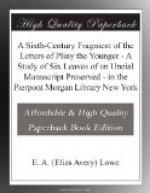[Footnote 14: C.P. V, p. 466.]
[Footnote 15: C.P. II, p. 156.]
[Sidenote: The Morgan fragment possibly a part of the lost Parisinus]
Perhaps we may now say the Bodleian volume has been hitherto our best authority. For a fragment of the ancient book, if my conjecture is right, is now, after various journeys, reposing in the Pierpont Morgan Library in New York City.
[Sidenote: The script]
First of all, we are impressed with the script. It is an uncial of about the year 500 A.D.—certainly venerandae vetustatis. If Aldus had this same uncial codex at his disposal, we can understand his delight and pardon his slight exaggeration, for it is only slight. The essential truth of his statement remains: he had found a book of a different class from that of the ordinary manuscript—indeed diversis a nostris characteribus. Instead of thinking him arrant knave or fool enough to bring down “antiquity” to the thirteenth century, we might charitably push back his definition of “nostri characteres” to include anything in minuscules; script “not our own” would be the majuscule hands in vogue before the Middle Ages. That is a position palaeographically defensible, seeing that the humanistic script is a lineal descendant of the Caroline variety. Furthermore, an uncial hand, though clear and regular as in our fragment, is harder to read than a glance at a page of it promises. This is due to the writing of words continuously. It takes practice, as Aldus says, to decipher such a script quickly and accurately. Moreover, the flesh sides of the leaves are faded.
[Sidenote: Provenience and contents]
We next note that the fragment came to the Pierpont Morgan Library from Aldus’s country, where, as Dr. Lowe has amply shown, it was written; how it came into the possession of the Marquis Taccone would be interesting to know. But, like the Parisinus, the book to which our fragment belonged had not stayed in Italy always. It had made a trip to France—and was resting there in the fifteenth century, as is proved by the French note of that period on fol. 51r. We may say “the book” and not merely “the present six leaves,” for the fragment begins with fol. 48, and the foliation is of the fifteenth century. The last page of our fragment is bright and clear, showing no signs of wear, as it would if no more had followed it;[16] I will postpone the question of what probably did follow. Moreover, if the probatio pennae on fol. 53r is Carolingian,[17] it would appear that the book had been in France at the beginning as well as at the end of the Middle Ages. Thus our manuscript may well have been one of those brought up from Italy by the emissaries of Charlemagne or their successors during the revival of learning in the eighth and ninth centuries. The outer history of our book, then, and the character of its script, comport with what we know of Aldus’s Parisinus.




